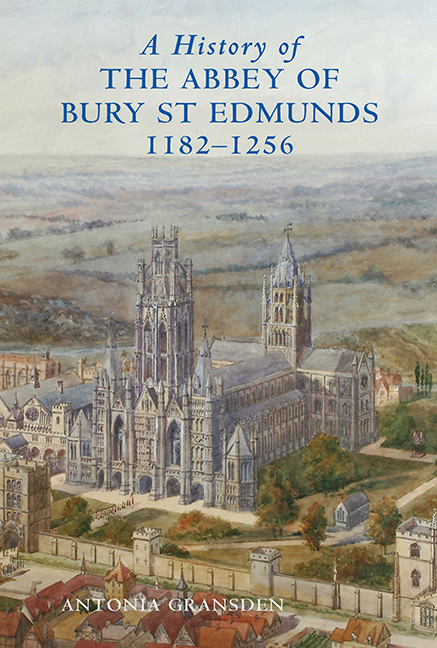Book contents
- Frontmatter
- Dedication
- Contents
- List of plates
- List of figures
- Preface
- Editorial Note
- Epigraph
- Acknowledgements
- Maps and plans (figures 1–9)
- Part I Samson of Tottington, Abbot 1182–1211
- 1 Samson's biographer, Jocelin of Brackland (de Brakelond), and his work
- 2 Samson's early life and career
- 3 Samson's election to the abbacy
- 4 The early years of Samson's abbacy and reform of estate management
- 5 Conflict with the convent
- 6 Relations with the town of Bury St Edmunds
- 7 Samson and secular law
- 8 Samson and the knights of St Edmund
- 9 Relations with the Angevin kings
- 10 Samson and the papacy
- 11 Samson as a builder
- 12 Religious and intellectual life under Samson
- 13 Samson's death and burial
- PART II The Abbey 1212–1256
- APPENDICES
4 - The early years of Samson's abbacy and reform of estate management
from Part I - Samson of Tottington, Abbot 1182–1211
Published online by Cambridge University Press: 29 April 2017
- Frontmatter
- Dedication
- Contents
- List of plates
- List of figures
- Preface
- Editorial Note
- Epigraph
- Acknowledgements
- Maps and plans (figures 1–9)
- Part I Samson of Tottington, Abbot 1182–1211
- 1 Samson's biographer, Jocelin of Brackland (de Brakelond), and his work
- 2 Samson's early life and career
- 3 Samson's election to the abbacy
- 4 The early years of Samson's abbacy and reform of estate management
- 5 Conflict with the convent
- 6 Relations with the town of Bury St Edmunds
- 7 Samson and secular law
- 8 Samson and the knights of St Edmund
- 9 Relations with the Angevin kings
- 10 Samson and the papacy
- 11 Samson as a builder
- 12 Religious and intellectual life under Samson
- 13 Samson's death and burial
- PART II The Abbey 1212–1256
- APPENDICES
Summary
Samson inherited a difficult situation from Abbot Hugh. Jocelin, writing of Hugh in his old age, asserts that although the Rule of St Benedict was observed and discipline kept, the abbey's administration was in a bad state and the abbey seriously in debt. He writes:
Abbot Hugh had grown old and his eyes dim. He was a pious, kindly man, a strict monk and good, but in worldly affairs he was neither good nor prudent. He trusted those about him too much, believed them too readily, always relying on their advice rather than on his own judgement.
Hugh did not control those who had charge of his portion of St Edmunds’ property, nor the obedientiaries responsible for the convent's portion. He allowed his vills and hundreds to be leased out, his woods to be destroyed and manors to fall into disrepair. His only remedy to maintain his household's honour was to borrow, and as interest was added to capital, the unpaid debts grew ever larger. Each obedientiary tended to follow suit, and, since each had acquired his own seal, he could transact business without the rest of the convent knowing. Among the examples given by Jocelin is of a debt privately contracted by the sacrist, Master William, to Benedict, the famous Jewish money-lender of Norwich. When the debt had reached £100 King Henry heard of it and informed the abbot and convent. Abbot Hugh was enraged but his intimates dissuaded him from deposing William, who promised that the debt would be repaid. To repay the debt William borrowed again, and finally he borrowed £880, to be paid off at the rate of £80 a year. In all, Jocelin asserts, Benedict was owed £1,200, excluding interest. Later the king remonstrated again at the abbey's indebtedness, and on another occasion (sometime between April 1174 and April 1175) Archbishop Richard did likewise. Thus, debt and maladministration were the main problems facing Samson at the outset of his rule.
Once abbot, Samson had the canonical duty to care for and protect the abbey's property and to recover any that was lost.
- Type
- Chapter
- Information
- A History of the Abbey of Bury St Edmunds, 1182–1256Samson of Tottington to Edmund of Walpole, pp. 23 - 31Publisher: Boydell & BrewerPrint publication year: 2007

